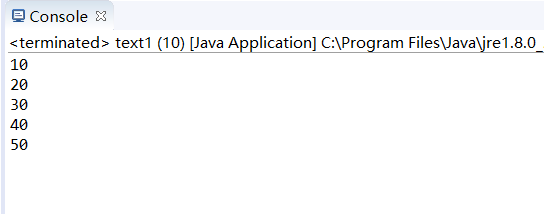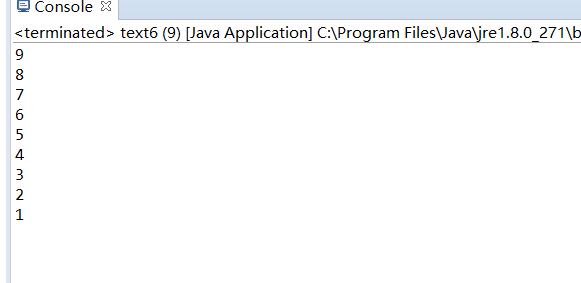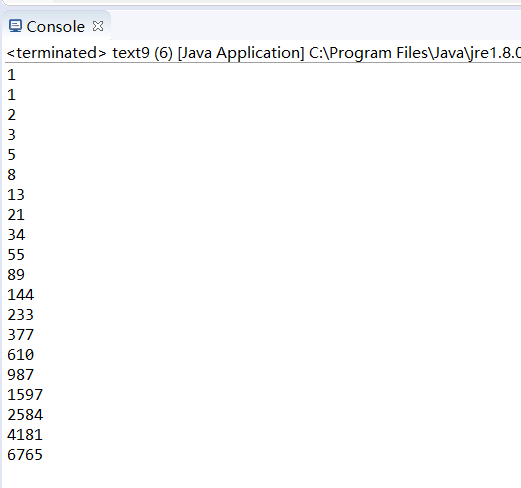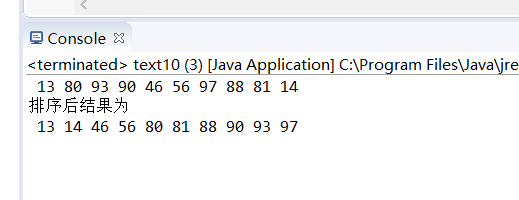1、编写一个简单程序,要求数组长度为5,分别赋值10,20,30,40,50,在控制台输出该数组的值。(知识点:数组定义和创建、一维数组初始化)[必做题]?
package chap7; public class text1 { public static void main(String[] args) { // 1、编写一个简单程序,要求数组长度为5,分别赋值10,20,30,40,50, //在控制台输出该数组的值。(知识点:数组定义和创建、一维数组初始化)[必做题]? int a[] = { 10, 20, 30, 40, 50 }; for (int i = 0; i < a.length; i++) { System.out.println(a[i]); } } }

2、将一个字符数组的值(neusofteducation)拷贝到另一个字符数组中。(知识点:数组复制) [必做题]?
package chap7; public class text2 { public static void main(String[] args) { // 2、将一个字符数组的值(neusofteducation)拷贝到另一个字符数组中。 // (知识点:数组复制) [必做题]? char a[] = { ‘n‘, ‘e‘, ‘u‘, ‘s‘, ‘o‘, ‘f‘, ‘t‘, ‘e‘, ‘d‘, ‘u‘, ‘c‘, ‘a‘, ‘t‘, ‘i‘, ‘o‘, ‘n‘, ‘a‘, ‘b‘, ‘c‘ }; char b[] = new char[16]; System.arraycopy(a, 0, b, 0, 16); System.out.println("输出数组a"); for (int i = 0; i < a.length; i++) { System.out.print(a[i]); } System.out.println(); System.out.println("输出数组b"); for (int i = 0; i < b.length; i++) { System.out.print(b[i]); } } }

3、给定一个有9个整数(1,6,2,3,9,4,5,7,8)的数组,先排序,然后输出排序后的数组的值。(知识点:Arrays.sort排序、冒泡排序)
package chap7; import java.util.Arrays; public class text3 { public static void main(String[] args) { // 3、给定一个有9个整数(1,6,2,3,9,4,5,7,8)的数组, // 先排序,然后输出排序后的数组的值。(知识点:Arrays.sort排序、冒泡排序) int a[] = { 1, 6, 2, 3, 9, 4, 5, 7, 8 }; System.out.println("系统排序"); Arrays.sort(a); for (int i = 0; i < a.length; i++) { System.out.print(" "+a[i]); } System.out.println(); System.out.println("冒泡排序"); for (int i = 0; i < a.length - 1; i++) { for (int j = 0; j < a.length - 1 - i; j++) { if (a[j] > a[j + 1]) { int temp = a[j]; a[j] = a[j + 1]; a[j + 1] = temp; } } } System.out.print("排序后结果为"); System.out.println(); for (int i = 0; i < a.length; i++) { System.out.print(" " + a[i]); } } }

4、 输出一个double型二维数组(长度分别为5、4,值自己设定)的值。(知识点:数组定义和创建、多维数组初始化、数组遍历)
package chap7; public class text4 { public static void main(String[] args) { // 4、 输出一个double型二维数组(长度分别为5、4,值自己设定)的值。 // (知识点:数组定义和创建、多维数组初始化、数组遍历) double a[][] = new double[5][4]; for (int i = 0; i < a.length; i++) { for (int j = 0; j < a[i].length; j++) { a[i][j] = i + j; } } System.out.println("输出内容为"); for (int i = 0; i < a.length; i++) { for (int j = 0; j < a[i].length; j++) { System.out.print(" " + a[i][j]); } System.out.println(); } } }

5、 在一个有8个整数(18,25,7,36,13,2,89,63)的数组中找出其中最大的数及其下标。(知识点:数组遍历、数组元素访问) [必做题]?
package chap7; public class text5 { public static void main(String[] args) { // 5、 在一个有8个整数(18,25,7,36,13,2,89,63)的数组中找出 // 其中最大的数及其下标。(知识点:数组遍历、数组元素访问) [必做题]? int a[] = { 18, 25, 7, 36, 13, 2, 89, 63 }; int max = a[0]; int index = 0; for (int i = 0; i < a.length; i++) { if (a[i] > max) { max = a[i]; index = i; } } System.out.println("最大值为" + max + "数组下标为" + index); } }

作业
6、将一个数组中的元素逆序存放(知识点:数组遍历、数组元素访问)
package chap7; public class text6 { public static void main(String[] args) { // 6、将一个数组中的元素逆序存放(知识点:数组遍历、数组元素访问) int a[] = { 1, 2, 3, 4, 5, 6, 7, 8, 9 }; for (int i = a.length-1; i >= 0; i--) { System.out.println(a[i]); } } }

7. 将一个数组中的重复元素保留一个其他的清零。(知识点:数组遍历、数组元素访问)
package chap7; import java.util.Scanner; public class text7 { public static void main(String[] args) { // 7. 将一个数组中的重复元素保留一个其他的清零。(知识点:数组遍历、数组元素访问) Scanner input = new Scanner(System.in); int a[] = new int[8]; for (int i = 0; i < a.length; i++) { a[i] = input.nextInt(); } for (int i = 0; i < a.length; i++) { for (int j = 0; j < a.length; j++) { if (a[i] == a[j] && i != j) { a[j] = 0; } } } for (int i = 0; i < a.length; i++) { System.out.print(a[i]); } } }

8、给定一维数组{ -10,2,3,246,-100,0,5},计算出数组中的平均值、最大值、最小值。(知识点:数组遍历、数组元素访问)
package chap7; public class text8 { public static void main(String[] args) { // 8、给定一维数组{ -10,2,3,246,-100,0,5},计算出数组中的平均值、最大值、最小值。 // (知识点:数组遍历、数组元素访问) double a[] = { -10, 2, 3, 246, -100, 0, 5 }; double max = a[0], min = a[0]; double sum = 0; double avg = 0; for (int i = 0; i < a.length; i++) { sum += a[i]; avg = sum / a.length; if (a[i] > max) { max = a[i]; } if (a[i] < min) { min = a[i]; } } System.out.println("平均值为"+avg); System.out.println("最大值为"+max); System.out.println("最小值为"+min); } }

9、使用数组存放裴波那契数列的前20项 ,并输出 1 1 2 3 5 8 13 21
package chap7; public class text9 { public static void main(String[] args) { // 9、使用数组存放裴波那契数列的前20项 ,并输出 1 1 2 3 5 8 13 21 int a[]=new int [20]; int b = 1; int c = 0; int d =0; for (int i = 0; i < a.length; i++) { a[i]=b+c; b=c; c=a[i]; System.out.println(a[i]); } } }

10、生成一个长度为10的随机整数数组(每个数都是0-100之间),输出,排序后,再输出
package chap7; import java.util.Random; public class text10 { public static void main(String[] args) { // 10、生成一个长度为10的随机整数数组(每个数都是0-100之间),输出,排序后,再输出 Random random = new Random(10); int a[] = new int[10]; for (int i = 0; i < a.length; i++) { a[i] = random.nextInt(100); System.out.print(" "+a[i]); } System.out.println(); for (int i = 0; i < a.length - 1; i++) { for (int j = 0; j < a.length - 1 - i; j++) { if (a[j] > a[j + 1]) { int temp = a[j]; a[j] = a[j + 1]; a[j + 1] = temp; } } } System.out.print("排序后结果为"); System.out.println(); for (int i = 0; i < a.length; i++) { System.out.print(" " + a[i]); } } }

原文:https://www.cnblogs.com/193230109jhn/p/14695054.html